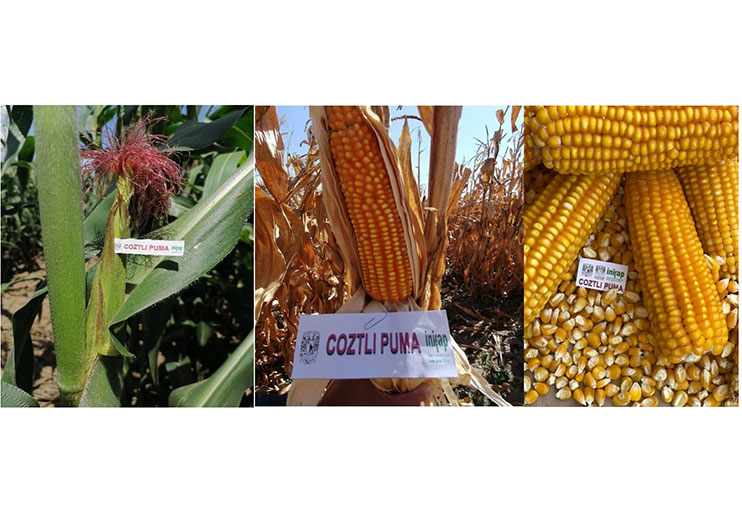Coztli Puma: variedad de maíz de polinización libre precoz de grano amarillo
DOI:
https://doi.org/10.29312/remexca.v15i5.3198Palabras clave:
Zea mays L., grano amarillo precoz, Valles Altos, variedad de maízResumen
In Mexico, corn (Zea mays L.) is the most important crop due to its sown area (7.4 million ha), its consumption of more than 200 kg person-1 year-1 and its role in the economy. However, Mexico imports 15.5 to 17 million t of yellow corn grain each year, these volumes are mainly destined for the livestock feed industry, as well as other destinations. In the Central Mexican Plateau (2 200 to 2 600 masl), in 1.5 million hectares sown with corn, in more than 50% of that area, the moisture for the crop comes from rainfall, which arrives late, insufficient and irregular, this forces late sowing and the crop to be affected by early frosts, since long-cycle varieties do not reach maturity and yields are low (1.2 t ha-1). In 2021, Kuautli Puma, Mistli UNAM, and Coztli Puma were registered, corn varieties that could support grain production as they present earliness and high productivity in conditions of delayed rainfall, limiting environments, late sowing, and short frost-free period. This variety description describes the phenotypic characteristics and agronomic advantages of the yellow-grain free-pollinated variety named Coztli Puma. This variety yields an average of 7.9 t ha-1 and is an alternative for corn producers in Valles Altos. Coztli Puma was registered in the national catalog of plant varieties (CNVV, for its acronym in Spanish) and holds the breeder’s title: 2849, granted on December 21, 2021.
Descargas
Citas
Espinosa, C. A.; Tadeo, R. M.; Gómez, M. N.; Sierra, M. M.; Virgen, V. J.; Palafox, C. A.; Caballero, H. F.; Vázquez, C. G.; Rodríguez, M. F. A. y Valdivia, B. R. 2010. V-54 A, nueva variedad de maíz de grano amarillo para siembras de temporal retrasado en los Valles Altos de México. Revista Mexicana de Ciencias Agrícolas. 1(4):677-680.
Espinosa, C. A.; Tadeo, R. M.; Gómez, M. N. O.; Sierra, M. M.; Virgen, V. J.; Palafox, C. A.; Caballero, H. F.; Vázquez, C. G.; Rodríguez, M. F. A.; Valdivia, B. R.; Arteaga, E. I. y González, R. I. 2011. V–55 A’, variedad de maíz de grano amarillo para los Valles Altos de México. Revista Fitotecnia Mexicana. 34(2):149-150.
Espinosa-Calderón, A.; Tadeo-Robledo, M.; Zamudio-González, B.; Virgen-Vargas, J.; Turrent-Fernández, A.; López-López, C.; Gómez-Montiel, N.; Sierra-Macías, M.; Vázquez-Carrillo, G.; Rodríguez-Montalvo, F.; Canales-Islas, E. I.; Zaragoza-Esparza, J. A.; Valdivia-Bernal, R.; Cárdenas-Marcelo, A. L.; Andrés-Meza, P. y Martínez-Yañez, B. 2021. HV 60 A: híbrido varietal de maíz amarillo para siembras retrasadas en Valles Altos de México. Revista Fitotecnia Mexicana. 44(1):127-129.
García, E. J. C.; Canales, I. E. I.; Tadeo, R. M.; Espinosa, C. A.; Zamudio, G. B. y Martínez, G. A. 2018. Rendimiento de híbridos varietales elite de maíz de grano amarillo para Valles Altos de México. En: acta fitogenética 5, sociedad mexicana de fitogenética (SOMEFI). 5(1):79-79.
Luna, M. B. M.; Hinojosa, R. M. A.; Ayala, G. O. J.; Castillo, G. F. y Mejía, C. J. A. 2012. Perspectivas de desarrollo de la industria semillera de maíz en México. Revista Fitotecnia Mexicana. 35(1):1-7.
SADER. 2020. Secretaría de Agricultura y Desarrollo Rural. Reporte del mercado de maíz. 18 p. https://www.cima.aserca.gob.mx/work/models/cima/pdf/cadena/2020/Reporte-mercado-maiz-200120.pdf.
Tadeo, R. M. y Espinosa, C. A. 2004. Producción de semilla y difusión de variedades e híbridos de maíz de grano amarillo para Valles Altos de México. Revista FESC Divulgación Científica Multidisciplinaria. 4(14):5-10.

Descargas
Publicado
Cómo citar
Número
Sección
Licencia
Derechos de autor 2024 Revista Mexicana de Ciencias Agrícolas

Esta obra está bajo una licencia internacional Creative Commons Atribución-NoComercial 4.0.
Los autores(as) que publiquen en Revista Mexicana de Ciencias Agrícolas aceptan las siguientes condiciones:
De acuerdo con la legislación de derechos de autor, Revista Mexicana de Ciencias Agrícolas reconoce y respeta el derecho moral de los autores(as), así como la titularidad del derecho patrimonial, el cual será cedido a la revista para su difusión en acceso abierto.
Los autores(as) deben de pagar una cuota por recepción de artículos antes de pasar por dictamen editorial. En caso de que la colaboración sea aceptada, el autor debe de parar la traducción de su texto al inglés.
Todos los textos publicados por Revista Mexicana de Ciencias Agrícolas -sin excepción- se distribuyen amparados bajo la licencia Creative Commons 4.0 atribución-no comercial (CC BY-NC 4.0 internacional), que permite a terceros utilizar lo publicado siempre que mencionen la autoría del trabajo y a la primera publicación en esta revista.
Los autores/as pueden realizar otros acuerdos contractuales independientes y adicionales para la distribución no exclusiva de la versión del artículo publicado en Revista Mexicana de Ciencias Agrícolas (por ejemplo incluirlo en un repositorio institucional o darlo a conocer en otros medios en papel o electrónicos) siempre que indique clara y explícitamente que el trabajo se publicó por primera vez en Revista Mexicana de Ciencias Agrícolas.
Para todo lo anterior, los autores(as) deben remitir el formato de carta-cesión de la propiedad de los derechos de la primera publicación debidamente requisitado y firmado por los autores(as). Este formato debe ser remitido en archivo PDF al correo: revista_atm@yahoo.com.mx; revistaagricola@inifap.gob.mx.
Esta obra está bajo una licencia de Creative Commons Reconocimiento-No Comercial 4.0 Internacional.


